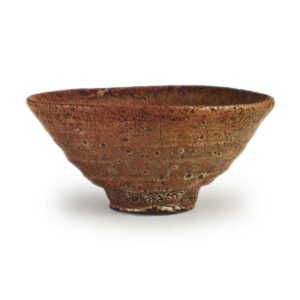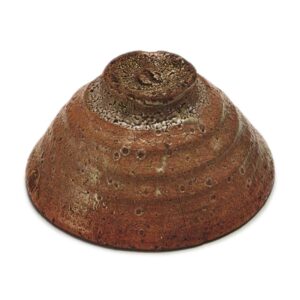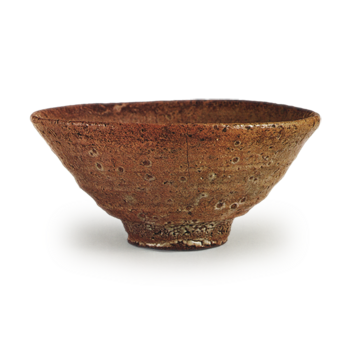

Meibutsu
Height: 6.6cm
Diameter: 14.0cm
Outer diameter of foot ring: 5.5cm
Height of foot ring: 1.0cm
The gold-painted characters on the inside of the lid of the box read “Korya teacup Kasugano”, but the author is not sure.
The name is thought to be derived from the glaze, which has a subdued color tone but also a certain festive quality, and which evokes the scenery of Kasugano. The glaze on the inside is particularly noteworthy, and the beauty of the glaze, which has a hint of redness, is probably one of the best pieces of Aoido ware.
The shape, which widens out from the foot ring to the rim, is well-balanced, with five levels of wheel marks, and the foot ring is slightly deep, and the size of the foot ring is also kept even in relation to the upper part. The outer body glaze is almost completely divided into two parts, with one side being strongly red and the other side being bluish, and a bluish white glaze is applied on top of this, but the surface is also characterized by the scattering of small and large perforations, creating a polka dot-like appearance.
The peony-skin pattern on the foot ring is particularly well-defined, extending from the foot ring to the outer rim of the bowl. As mentioned above, the subtle reddish hue from the tea-drip area to the body is particularly beautiful, and the rim is tinged with blue. The glaze is generally a little thin, and the cracks are relatively fine. Although this tea bowl has no marks on the inside, the elegance of its appearance means that it does not feel at all lonely.
The history of this tea bowl throughout the Edo period is unclear, and after the Meiji period it was in the collection of the Matsuoka family of Kanazawa, but it was used at the 300th anniversary of Toyotomi Hideyoshi’s death tea ceremony held at Shinjuan in Daitokuji temple on May 2nd and 3rd, 1908. After that, it became the property of Masuda Dono, and was used at the Soun-dai tea ceremony in April 1922, and the combination was as follows.
Hanging scroll: Zen Master Shouin Gekkei’s praise of Bodhidharma
Vase: single-layered, by Enshu, from Enshu’s storehouse, in jakuseki blue
Tea caddy: Mikuni-yama cherry blossoms, a famous tea caddy from the middle of the Edo period
Teacup Aoido, inscribed Kasugano
It is also said that, at the time, it was called one of the three famous Aoido teacups of the Eastern Capital, along with the Seo and Kato Masayoshi teacups of the Mitsui family’s Takeya. As an Aoido teacup, it is similar to the Shibata and Uji teacups, and while it is not as blue as the Shibata teacup, it is a teacup with relatively little blue coloring.



